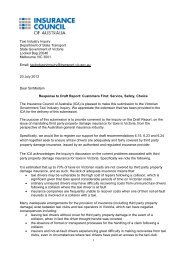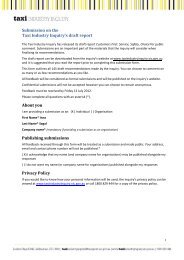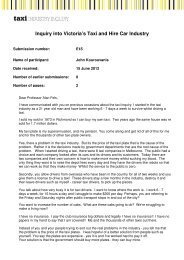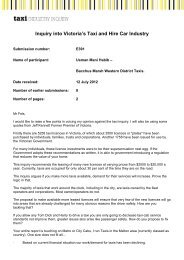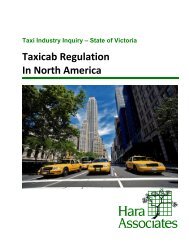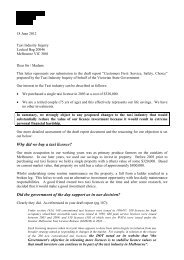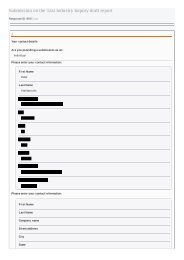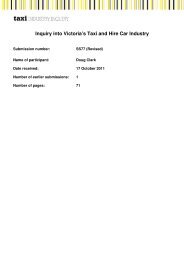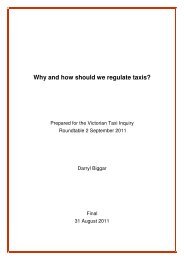Part D â Understanding and improving industry performance (PDF ...
Part D â Understanding and improving industry performance (PDF ...
Part D â Understanding and improving industry performance (PDF ...
You also want an ePaper? Increase the reach of your titles
YUMPU automatically turns print PDFs into web optimized ePapers that Google loves.
Historically, the zones generally reflected the catchment<br />
areas of local taxi-cab companies. They gave some<br />
protection to members of the local taxi cooperative<br />
against operators coming into the zone from other zones.<br />
In the metropolitan area, zones largely became redundant<br />
as taxi depots merged or were taken over by bigger<br />
operators <strong>and</strong> hire car licences (which provided services<br />
in outer suburbs) were converted to taxi licences. But<br />
remnants of the past remain, despite previous reviews<br />
having recommended the abolition of zones.<br />
10.4.2. Analysis of zones in previous<br />
reviews of Victorian taxi regulations<br />
Foletta review<br />
In 1986, the Foletta review 80 recommended that the<br />
Road Traffic Authority extend the metropolitan zone taxi<br />
boundary to include the then Frankston <strong>and</strong> D<strong>and</strong>enong<br />
zones <strong>and</strong> convert all the country licences in these zones<br />
to metropolitan licences with full rights. At the time, the<br />
fares that applied in the two zones were different to those<br />
in the metropolitan zone. Foletta noted that most people<br />
considered the Frankston <strong>and</strong> D<strong>and</strong>enong zones to<br />
be part of the metropolitan area <strong>and</strong> that uniform fares<br />
should apply across the whole metropolitan area. He<br />
considered the existing boundary of the metropolitan area<br />
to be illogical.<br />
These recommendations followed lobbying by Black<br />
Cabs, which considered the zones severely restricted<br />
the availability of cabs in newer areas. The Frankston<br />
<strong>and</strong> D<strong>and</strong>enong depots argued that the zones helped<br />
to maintain local services by keeping their cabs in<br />
their zones. Foletta recognised that the Frankston <strong>and</strong><br />
D<strong>and</strong>enong depots provided a better level of service, but<br />
considered that they would continue to do this without<br />
the zones. The depots were strongly established in their<br />
local areas <strong>and</strong> well placed to meet competition from<br />
metropolitan operators.<br />
KPMG National Competition Policy review<br />
KPMG examined legislative restrictions on competition<br />
<strong>and</strong> considered whether the benefits to the community<br />
of these identified restrictions outweighed the costs<br />
associated with them. One of the restrictions identified by<br />
KPMG was zoning, which had the effect of limiting entry<br />
of potential competitors.<br />
The review considered there was little substance to the<br />
claim that zoning protected operators who had greater<br />
underst<strong>and</strong>ing <strong>and</strong> experience of local issues <strong>and</strong><br />
concerns, commenting that “in the absence of the zone,<br />
the travelling public would choose to use the service<br />
that offers the best combination of price <strong>and</strong> service<br />
quality”. 81 The review considered that zones might help<br />
to ensure that service was maintained across a zone:<br />
“We are unable to quantify the magnitude of this benefit,<br />
but suspect with the current regulations in place on fares<br />
<strong>and</strong> entry it could be significant.” 82 However, the outer<br />
suburban zone provided less of a benefit in this respect.<br />
There is substantial traffic already existing in these<br />
zones (which is reflected in the similar licence values<br />
in comparison to the metropolitan zone), <strong>and</strong> the<br />
impact of merging the zones would be relatively<br />
small. Other outer suburban areas of Melbourne do<br />
not appear to have significant supply problems. 83<br />
While the public benefits associated with zoning were<br />
considered limited, there were significant costs created<br />
by zones, especially as a result of dead running:<br />
When a taxi-cab moves out of its zone on a fare it<br />
basically is resigned to returning to the zone without a<br />
fare. This increases the costs of operation <strong>and</strong> can<br />
even discourage working outside of that zone. 84<br />
There are further costs from limiting taxi-cab mobility.<br />
During high dem<strong>and</strong> periods in certain areas (e.g.<br />
Saturday nights in Melbourne) it is possible that outer<br />
suburban zone taxicabs could alleviate supply shortages<br />
<strong>and</strong> still service the outer suburban zone area. Similar<br />
situations could apply in country areas. 85<br />
The review concluded that the outer suburban zone<br />
“is a restriction on competition that is likely to have<br />
costs that outweigh its benefits. The zone makes an<br />
artificial distinction between this area <strong>and</strong> the Melbourne<br />
metropolitan region <strong>and</strong> should be removed.” 86<br />
Less information was available to the review to determine<br />
whether the benefits of country zones outweighed their<br />
costs. However, the review pointed out that the higher<br />
proportion of booked jobs in country markets weakened<br />
the case for zoning. This was even more the case if<br />
‘public interest’-based restrictions on entry were removed<br />
as recommended by the review. Accordingly, the review<br />
concluded that these zones should also be removed.<br />
80 Foletta, Bruce (1986), Op. Cit.<br />
81 KPMG (1999), Op. Cit., p.96<br />
82 Ibid., p.96<br />
83 Ibid., p.96<br />
84 Ibid., p.97<br />
85 Ibid., p.97<br />
86 Ibid., p.98<br />
<strong>Underst<strong>and</strong>ing</strong> <strong>industry</strong> <strong>performance</strong> CUSTOMERS FIRST 207





